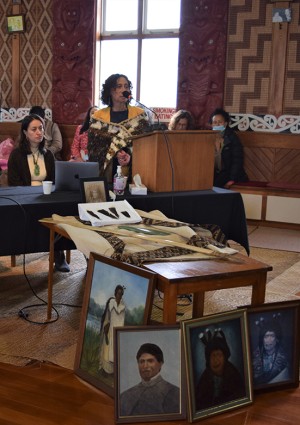Wāhine mātauranga
See more about what witnesses said about wāhine mātauranga in the areas of:
Taonga
Several witnesses presented taonga to the Tribunal.
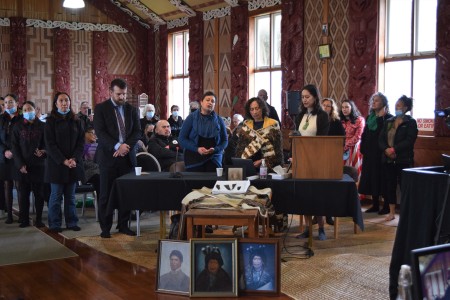
Heeni Collins (pictured) and other witnesses for the Ngāti Raukawa ancestral lands, resources and other property (Porter) (Wai 2419) claim appeared at Waiwhetū marae accompanied by a large ope from Ngāti Raukawa and several taonga. These included a picture of Te Rangitopeora, accompanied by the feathers shown in her hair in the picture, a korowai that Rangitopeora wore, a large whalebone taiaha, and Te Rangihaeata’s mere pounamu that he used to prevent the death of his wife Te Rongo in the Wairau affray.
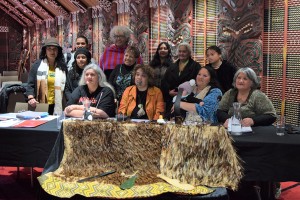
Ngāi Tamahaua witnesses pictured with whānau taonga
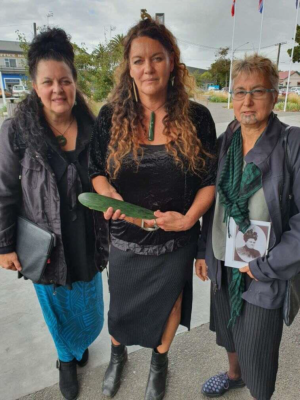
Stephanie Turner (centre) pictured with the mere, Amokura (pictured in document A109(a))
Weaving
Several witnesses said that weaving was a skill predominantly practiced by wāhine. Wāhine authority over this task demonstrated their mana, as the production of garments, textiles, and food storage items, were vital to the survival and wellbeing of the whānau and hapū. Witnesses also said that weaving practices transcended mere manual skills; it encoded mātauranga for future generations and maintained linkages with the natural and spiritual worlds.
Key witnesses who gave evidence
Barbara Ann Moke (doc A38)(external link) gave evidence on behalf of Te Whakaruruhau (Waikato Women’s Welfare League), in which she emphasised the importance of weaving, both in traditional Māori society and as a metaphor for the contemporary work of Te Whakaruruhau. She said, in traditional Māori society, weaving was an important role played by wāhine to provide for whānau and tamariki, including through creating kono (food basket), poki poki (one-panel green flax mat), poha (two-panel green flax mat), kete rīwai (green flax basket), kete whakairo (patterned kete), whāriki (panelled floor mat), piupiu (waist-to-knees garment of flax), kākahu (woven cloak), kahukiwi (kiwi feather cloak), and kaitaka (cloak with an ornamental border).
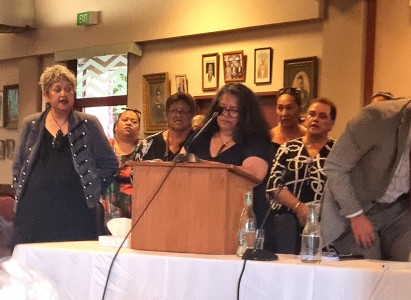
Barbara Ann Moke giving evidence at Tūrangawaewae Marae, Ngāruawāhia
What witnesses said
- “The status and roles of wahine played a crucial part in the wellbeing of the tribe. Weaving was an important necessity and often reserved to the wāhine for their skill and ability to produce garments, fabrics and textiles of quality and beauty. It set an example of the tribe; its image, reputation and hygiene.” (Patricia Henare, doc A104, p 4)(external link)
- “A well-known historical example of colonial gender-based assumptions about Māori women’s status relates to flax, identified by New South Wales political and mercantile leaders as a valuable trade item in the late eighteenth century. In 1793, two Māori men, Tuki Tahua (‘Tuki’) and Ngāhuruhuru Kokoti (‘Huru’) were kidnapped from near the Cavalli Islands by the HMS Daedalus on the orders of Lieutenant Governor Philip Gidley King. The two men were taken to Norfolk Island to teach convicts how to dress flax only for it to be discovered on arrival that they did not know how to work flax because dressing flax relied on the expertise and knowledge of women.” (Professor Angela Wanhalla, doc A82, p 3)(external link)
- “Erenora Puketapu-Hetet of Te Ati Awa explained that weaving is more than just a product of manual skills. From the simplest rourou to the prestigious Kahu Kiwi, weaving is endowed with the very essence of the spiritual values of Māori people. I add that the artist is a vehicle through whom the gods create. As kairaranga we create taonga, informed by the creative genius of our tūpuna and the native plants of the living land. These ageless practices and the taonga we create are permeated with our own present realities. The taonga then carry this tūpuna knowledge into the future in multiple forms. The practices of raranga and raranga whatu not only transform the materials the kairaranga is using, but also the kairaranga themselves. These practices become self-affirming, and culturally affirming. Creating taonga from our tupuna’s native plants powerfully connect us to the whenua in an affirmation of culture. Te pā harakeke provide many medicinal properties for our people, encapsulating a physical, mental and spiritual te ao Māori. Embodied within the practice of raranga and whatu are te reo, tikanga and mātauranga Māori, which uphold and sustain the Māori world view, along with the centrality of women within that world view.” (Aroha Rickus, doc A140, pp 3-4)(external link)
- “Most weavers are women. Basket weaving involved the custom in flax collecting. One does not cut flax from the centre of the plant. The making of objects with flax by wāhine was affected by their knowledge of the time of the year, weather, and purpose of the crafted object. The crafting of a basket for carrying kai was different from the construction of a basket for cradling tamariki.” (Violet Walker, doc A66, p 11)(external link)
- “The activity of weaving was generally considered to be what women would do, although some men have become highly respected weavers.” (Patricia Tauroa, doc A60, p 11)(external link)
Tohunga
Witnesses challenged the assumption that only tāne could be tohunga in traditional Māori life. They gave examples of wāhine who possessed profound expertise in various areas – including rongoa, raranga, waiata, and whakapapa. Wāhine tohunga possessed the ability to traverse both the living and non-living worlds. They offered physical healing through rongoā and spiritual healing through karakia; some wāhine tohunga had matakite (prophetic) abilities, and others were experts in mahi tūpapaku (funeral rites). Witnesses gave examples of wāhine tohunga guiding the choices hapū made about where they would settle. Some witnesses also made allegations about the impact of suppression of this knowledge in the colonial era.
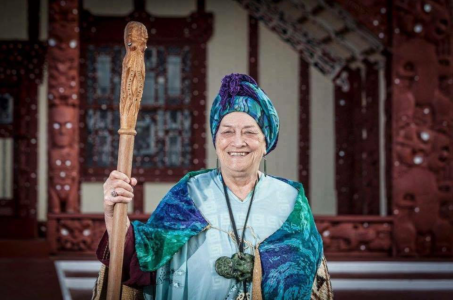
Rangimarie Rose Pere (pictured in document A54(b))
What witnesses said
- “There always have been female tohunga in Māori society. Those who are seers, those who know rongoa, those who are experts at rāranga, those who are skilled at waiata, and those who hold whakapapa. Many women were seen as tohunga in the skills and art of mahi-ā-ringa, and in the composing of waiata. It appears to me, again, that the skills held by Māori women have been minimised simply because of the colonial attitude against Māori as an indigenous people – the subservience of women beneath the Pākeha male, accordingly, meant that, like Māori people in general, the skills held by Māori women were deemed to be of no value or lesser value than the skills held by a male. As an example, the craft of making tukutuku panels is as difficult as that of carving a pou, yet attention is regularly paid to the carvings, but not so much to the tukutuku or kōwhaiwhai panels.” (Patricia Tauroa, doc A60, p 13)(external link)
- “There appears to be an assumption that only men became tohunga, and only men carried mātauranga to pass on to their future generations. This also is a myth … in the kōrero for Tāwhaki, the kuia who held ngā kete mātauranga, is most often given little relevance, and the focus is, instead, on the tōhunga qualities of Tāwhaki.” (Patricia Tauroa, doc A60, p 12)(external link)
- “The traditional role of tohunga was carried out by women and men. They were the tribal elders who could foretell the destinies of children soon after the latter’s birth … Wāhine holding tohunga positions were knowledgeable. I would say, they knew it all. Tohunga had knowledge about making Rongoa Māori to relieve pain and to stop wāhine from bleeding during childbirth. Tohunga moved around and decided where the tribe made their home on the whenua. They considered such factors as soil fertility, water access, or sometimes kaimoana when scouting for pā locations.” (Violet Walker, doc A66, p 6)(external link)
- “Tohunga were the equivalent to the modern day nurse, they were able to manaaki those who were physically unwell as tohunga rongoa or provide spiritual sustenance as tohunga karakia. Tohunga had the ability traverse both the living world and the non-living world as carers for those who were unwell or otherwise helping to care for those who were given over to Hinenui-te-pō to move into the afterlife.” (Sandra Corbett, doc A45, p 4)(external link)
- “Tohunga: wahine Māori had deep and well practice capacity to sense and read / understand the tohu of the taiao, manu, hau, maramataka. Lifetimes of observation and succession and practice of this matauranga / knowledge and skills encouraged and developed expert behaviour and practices in these areas.” (Aorangi Kawiti, doc A24(a), p 10)(external link)
Karakia
Witnesses said karakia were important to all aspects of everyday life in pre-colonial society, as they are today. Karakia were used to connect with whakapapa and atua, and maintain separation between tapu and noa. They featured in activities ranging from tauā, to gathering kai, to childbirth. Karakia also encoded knowledge about whakapapa and atua – making them a valuable source of mātauranga for people today. Witnesses disputed that only tāne commanded karakia, giving examples of wāhine using karakia in contexts like performing rōngoa, birthing, burying placenta, and harvesting flax or kai. Witnesses also gave contemporary examples of wāhine practising karakia within the Rātana, Ringatū, and Anglican churches.
What witnesses said
- “When you gave birth there was special tikanga [and] special karakia.” (Materangatira Lily Porter, doc A16(a), p 7)(external link)
- “There was fluent practice in karakia before kai or rongoa was collected.” (Violet Walker, doc A66, p 11)(external link)
- “Na tēnei tapu i noho puku ai te wahine ki etahi o ngā tikanga o te iwi engari ki te tae ki te kikiitanga e kore ai e taea e te Tāne ngā karakia ma te tohunga ira wahine e whakaoti ngā karakia. Ko tēnei noho puku kia kaua ai e takahia tona tapu kia kaua ai hoki e pa te raruraru nui kia ratou. He whakaatu ano hoki ki te Tāne kia kaua tona ringa e pa patu i te wahine. Ko te wa ano tēnei e tukua ai te kakano o Papatuanuku ki roto ki te wahine e whānau tonu mai ai te tangata ki tēnei ao. Kei te wharetangata ano te mana nui hei whakaora i ngā mauiui o te takahi tapu o te makutu ranei i tukua mai e tētahi atu.
It is because of this sacredness that the woman remains silent under some customs of the people but should the male tohunga prayers fail then the female tohunga completes the prayers. This silent position is so that her sacredness is not desecrated and therefore avoids possible catastrophe to the people. This is also a teaching to the male element that striking a woman is forbidden. This is also the time that the seed of Papatuanuku is released into the woman so that mankind continues to be born into this world. The sacredness of the birth passage of the woman also holds the power to restore wellness of illnesses as a consequence of sacredness being breached or from a curse that has been sent by someone else.” (Hana Maxwell, doc A69, p 3)(external link) - “In the cases where a difficult birth occurred a priest was called in to recite appropriate karakia, incantations. [Bruce] Biggs does not mention whether the ‘priest’ was male or female, no doubt assuming that the ‘priest’ had to be a male, as would many of the readers of such a statement … Makereti [Papakura] also notes that women generally gave birth alone, and they or one of their female relatives buried the afterbirth, the whenua, whilst intoning appropriate karakia. Thus, women were familiar with ritual karakia, associated with one of the most important aspects of any society, the replacement of its members through childbirth.” (Professor Ella Henry, doc A63, pp 22-23)(external link)
- “Karakia was always an essential part of Māori life, and women knew karakia that was necessary for different elements of life not just for Christian occasions … my grandmother always recited karakia as we went about gathering kōrari (flax) and other rongoa from along the riversides, is confirmation that women learned, and practised karakia. It wasn’t only men who did karakia Māori.” (Patricia Tauroa, doc A60, pp 8, 11)(external link)
- “Wāhine are traditionally matakite and certain things could only be done with their guidance, including both physical healing (broken bones, cracked skulls, skin and stomach ailments) and spiritual healing (using special water and medicines, and karakia). They could commune with the ‘other world.’ Our grandmother was an example of those kuia who could see and speak to the matangaro or hidden. I believe it was their attention to details in keeping the tapu realm separate from the noa that enabled them to do this. … Wāhine and kuia played a central ceremonial role at the time of harvesting. They would recite karakia and this was an essential step in the process – we would not touch the harvest until wāhine and kuia had completed the ceremony. The wāhine were the only ones who could recite the karakia. These karakia recite whakapapa back to wāhine atua.” (Rereata Makiha, doc A71, pp 5-6)(external link)
- “Nothing was ever done without karakia. That is because we are all connected through whakapapa, connected to the plants, to land, to whatever! It is all evident through our stories. Therefore, it is our job to ensure that all those things are cared for. That is what our job is as mana wāhine. It is about protecting those things like the wai, because the wai is us. I know that karakia, which was done by wāhine, and was really, important, pre-1840. It was about maintaining those resources so that the generations to come will be hauora tongi.” (Paihere Clarke, doc A141, pp 7-8)(external link)
- “There was also karakia when a baby was born to give thanks for their safe arrival, to rejoice, to give thanks for the mother and for her wellbeing and to ask for blessing for the many days to come.” (Robyn York, doc A65, p 10)(external link)
Waiata
Waiata are a key source of mātauranga about pre-colonial Māori life – both in their kupu, and in the stories of their composition. Witnesses gave numerous examples of waiata that were composed by wāhine rangatira, memorialising their status and deeds. However, witnesses noted that waiata produced after colonisation reflect the influence of patriarchal settler culture, which increasingly prioritised stories of tāne over those of wāhine.
Several witnesses also shared their gifts in waiata and contemporary poetry – including Whirimako Black ONZM who is an award-winning musician, appointed a member of the New Zealand Order of Merit in 2006 for services to Māori music (doc A84). Other witnesses who shared mōteatea or waiata in giving evidence were Aroha Rickus (doc A140, pp 14-15),(external link) Tracy Hiller (doc A92, pp 14-15),(external link) Te Rangitunoa Black (doc A99),(external link) Materoa Dodd (doc A98),(external link) and Jessica Williams (doc A61, pp 8-10).(external link)
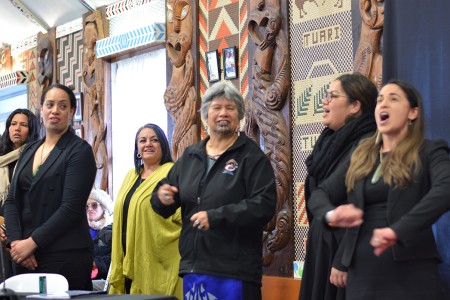
Waiata tautoko for Heeni Brown (left)
Key witnesses who gave evidence
Anna Kurei (doc A100)(external link) described waiata as a medium for passing knowledge, both sacred and profane, between people and generations. Waiata were a primary means of teaching and learning in whare wananga, kura wananga or school of sacred knowledge. Most of her brief of evidence and oral presentation focused on the ancient waiata ‘Te Tapu o Muriwai’ which contained ancient knowledge about the relationships that Te Whakatōhea held to the environment and neighbouring iwi and hapū.
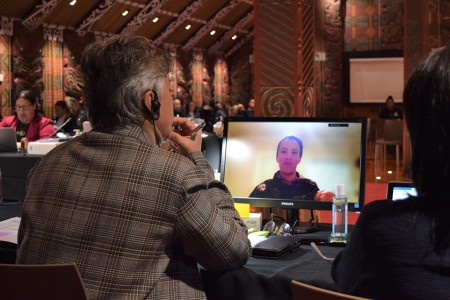
Anna Kurei giving evidence virtually, pictured with Judge Sarah Reeves, July 2022
What witnesses said
- “The many waiata tawhito composed by women show how vital mana wahine were in the preservation and transfer of iwi history and knowledge. Such waiata written by women, some of whom were prolific composers, are abundant in pre-European contact Nga Mōteatea, therefore it would seem to reason that individuals in charge of ensuring the iwi’s physical existence and continuation would also have a considerable impact on preserving its history and, by extension, its identity.” (Hinemoa Ranginui-Mansell, doc A129, pp 3-4)(external link)
- “In Taranaki, male leadership and statements or exhortations by male leaders appear predominantly in Taranaki waiata and kōrero. In contrast, reference to female leadership, actions and/or statements is minimal, if not almost non-existent in kōrero and waiata. For example, kōrero and waiata relating to Parihaka makes mention of rangatira tāne – of Te Ua Haumēne, of Titokowaru, of Te Whetu Moeahu, and of Tohu Kākahi and Te Whiti-ō-Rongomai. However, there is no substantial reference to rangatira wahine of that time. It is not that these rangatira tāne do not deserve mention. Rather, it is that rangatira wahine deserved equal mention, yet were not. Therefore, it could be said that there is a general invisibility of mana wahine in historical documentation.” (Aroaro Tamati, doc A131, p 4)(external link)
- “‘Te Pu Te More Te Aka Te Weu Te Rea, Te Waonui Te Kune Te Kore Te Po, Ki nga tangata Māori na Rangi raua ko Papa, Ko tenei te timatatanga O Te Ao.’ This overview of Papatuanuku through karakia and waiata is an introduction to the creation of the Māori world and the role of Papa, the female essence of that Māori world.” (Hana Maxwell, doc A69, p 1)(external link)
